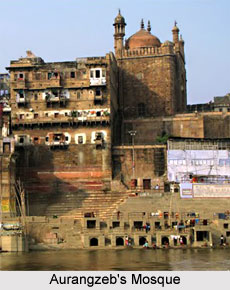 Aurangzeb"s Mosque is located in the Indian state of Uttar Pradesh. More specifically, this mosque is situated in Panchaganga Ghat in Varanasi. This ghat is revered as a sacred bathing place in Varanasi. It has broad steps that go down to the Ganges. This ghat gained popularity and prominence during the Gahadavala period (11th-12th centuries) and was patronized by the royal family. Globally, Aurangzeb`s Mosque can be pinpointed at coordinates 25 degrees,18.909 minutes north and 83 degrees 01.074 minutes east. It was built in the late 17th century. This mosque was built by the Mughal Emperor Aurangzeb on the foundations of old Vireswar Temple. This mosque is also known by the other name of Jnana Vapi Mosque. This mosque has historical, cultural and natural significance. A water-colour painting of Aurangzeb`s Mosque will be evident to the visitors across the River Ganges. The painting is known to have been created by Robert Smith (1787-1873) in 1814-1815. The word Benares has been inscribed on the mount in pencil.
Aurangzeb"s Mosque is located in the Indian state of Uttar Pradesh. More specifically, this mosque is situated in Panchaganga Ghat in Varanasi. This ghat is revered as a sacred bathing place in Varanasi. It has broad steps that go down to the Ganges. This ghat gained popularity and prominence during the Gahadavala period (11th-12th centuries) and was patronized by the royal family. Globally, Aurangzeb`s Mosque can be pinpointed at coordinates 25 degrees,18.909 minutes north and 83 degrees 01.074 minutes east. It was built in the late 17th century. This mosque was built by the Mughal Emperor Aurangzeb on the foundations of old Vireswar Temple. This mosque is also known by the other name of Jnana Vapi Mosque. This mosque has historical, cultural and natural significance. A water-colour painting of Aurangzeb`s Mosque will be evident to the visitors across the River Ganges. The painting is known to have been created by Robert Smith (1787-1873) in 1814-1815. The word Benares has been inscribed on the mount in pencil.
Architectural Design of Aurangzeb`s Mosque
Aurangzeb`s Mosque is known to have been made of the remains of an ancient temple. It is stretched over a wide area. It stands as an illustration of exquisite workmanship. Researchers had prepared an excellent ground plan of the mosque, according to which the mosque along with its terrace displays architectural variance. It roughly is directed to four religious communities i.e. Buddhist, Jain, Hindu and Mohammedan. The mosque compound is known to spread over an area of about 0.108 ha.
The courtyard of the mosque has a terrace that is five feet above the level of the temple-quadrangle. There are unusual openings or niches in the remaining walls of the mosque. In some places, the openings are filled with earth, almost up to the level of the capitals.
The base of the mosque gradually declines from west to east. Descending down the steps of the mosque, a large stone bull or Nandi will be evident to the visitors. The cloister is divided into a number of small chambers. These are sustained by Buddhist pillars. The pillars have been carved beautifully but in a simple way. The architectural work of the pillars in the mosque states about its antiquity. The square terrace pillars with their cruciform capitals are so simple in structure, that they almost belong to another style of architecture. It might be called early Buddhist or Hindu style of architecture. As per the research work conducted here, it is thought that the succession of cloisters formed the lowermost story of a vihara or temple monastery. They must have risen to the height of almost two or three storey above it.
A temple existed on the southern side of Aurangzeb`s Mosque that was later rebuilt. On the northern side there were high pillars that had been transferred. Judging from these remains it has been proved that it was the old Vireswar temple that had been destroyed to build the mosque.
Managing Body of Aurangzeb`s Mosque
The Sunni (Muslim) Wakhf (or Waquf) Board deals with the administration and management of the Aurangzeb`s Mosque. It is recognized as a charitable trust. Mutawalli is the representative of this mosque. He is identified as a priest-cum-administrator.
Visiting Information
Lal Bahadur Shastri Airport or Varanasi Airport is well-connected to some of the major cities in India like Delhi and Mumbai via airlines. Air India and Indi Go are some of the domestic airlines which arrange regular flights to Varanasi. International tourists would have to arrive at the Delhi airport. Delhi airport is well-connected to all the important cities in India as well as world. The Varanasi Railway Junction and the Kashi Railway Station are known to be the two major railheads in Varanasi. Extensive rail networks of the above mentioned railway stations connect Varanasi to important cities in India. Roads in Varanasi are motorable by modes of transportation namely, buses, auto rickshaws and taxis. State-run buses connect Varanasi to major cities of Uttar Pradesh and the neighbouring states. Cities close to Varanasi are also connected to it via private air-conditioned buses. National highways also connect Varanasi to other cities in Uttar Pradesh. For example, the well-maintained national highways namely, NH 2 and NH 28 (via Harlalka Road) will take one to Varanasi from Lucknow.
Related Articles
Mosques in India
Mosques During Aurangzeb, Mughal Architecture
Akbari Mosque, Ajmer
Begampur Mosque
Afsarwala Mosque





















